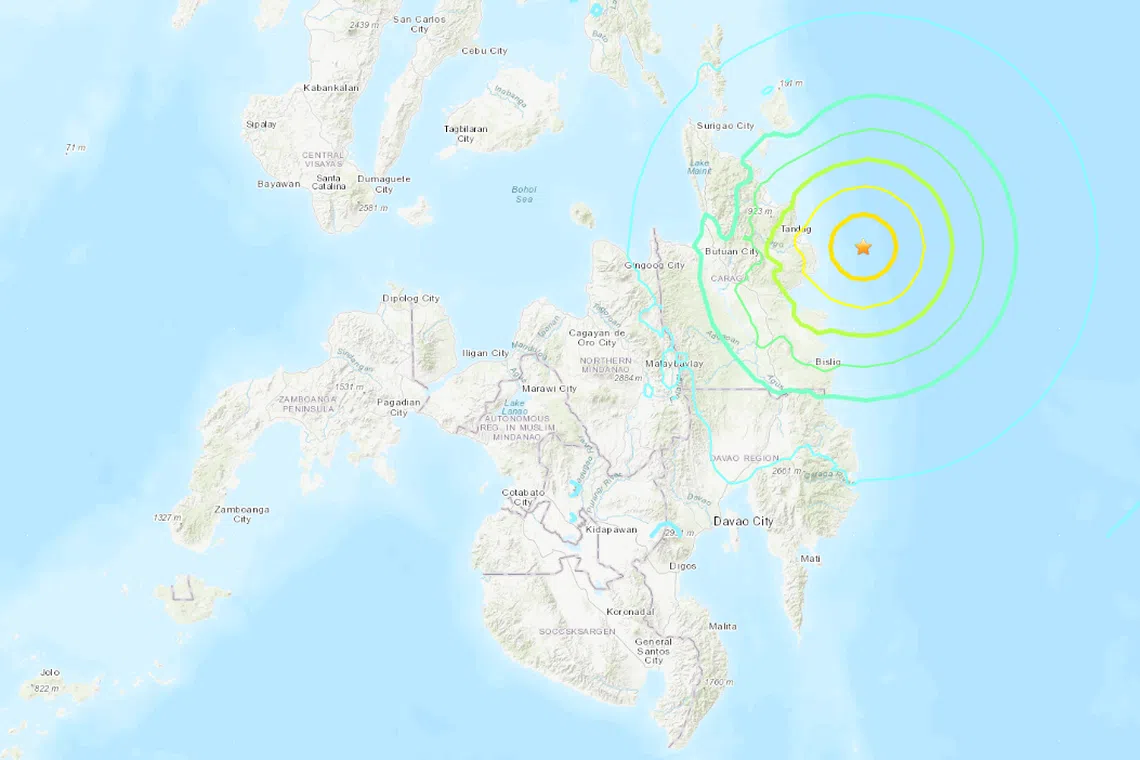Death toll from Philippine quake rises to three
Sign up now: Get ST's newsletters delivered to your inbox

Residents fetch water next to a destroyed house in Hinatuan, Surigao del Sur province.
PHOTO: AFP
Follow topic:
MANILA – The death toll from a powerful earthquake in the southern Philippines has risen to three, official tallies showed on Dec 4, as frequent aftershocks sent residents fleeing into the streets.
At least eight people have also been injured since the magnitude 7.6 quake hit on Dec 2 off the coast of Mindanao island, in an area that has seen a series of aftershocks of magnitudes exceeding 6 until Dec 3.
A magnitude-6.9 quake hit the area early on Dec 4 at a depth of 30km, about 72km north-east of Hinatuan municipality in Surigao del Sur province, the US Geological Survey said.
“Up to now, we’re still terrified because there are many aftershocks,” Mr Alex Arana, head of the province’s disaster agency, told broadcaster DZBB.
As at the night of Dec 3, more than 30,000 families were staying in evacuation centres in Surigao del Sur, Mr Arana said.
Ms Josephine Ungab, 54, and her three children spent the night of Dec 2 in an evacuation centre in Hinatuan, about 21km from the epicentre of the initial quake.
They returned home the next day but were back at the shelter on Dec 4 after another strong tremor.
“Every time that there is an earthquake, we feel restless,” she said.
“It is as if our house will be destroyed by the quake and waves.”
Some walls and roads cracked, while more than 100 homes were destroyed and the roof of an outdoor courtyard collapsed.
Dec 4’s quake was “quite strong” but people did not panic this time, said Mr Allan Luna, a disaster officer in Cagwait municipality.
“Since they’ve experienced a similar quake already, they calmly went out of their houses and stayed outdoors for around an hour,” he said.
However, Staff Sergeant Joseph Lambo of the Hinatuan police said the quake on the evening of Dec 3 sent people rushing out of their homes.
“They were panicking due to the memory of the previous night’s quake,” he told AFP.
The quake on Dec 2 triggered tsunami warnings across the Pacific region and sent residents along the east coast of Mindanao fleeing buildings, evacuating a hospital and seeking higher ground.

Earthquake-affected residents ride a boat as they evacuate from Hinatuan, Surigao del Sur province on Dec 3, following a 7.6-magnitude quake late on Dec 2.
PHOTO: AFP
Collapsed wall kills man
Two people died in Surigao del Sur, Mr Arana said – one from falling debris and the other from a wall collapsing on top of him.
A pregnant woman was killed in Tagum city in Davao del Norte province, the national disaster agency said, without providing details.
Mr Arana said eight people were injured in his province.

The earthquake on Dec 4 hit just before 4am local time at a depth of 30km, some 72km north-east of Hinatuan municipality on Mindanao island.
PHOTO: SCREENGRAB FROM USGS
The Philippine seismology institute said Dec 2’s quake was generated by the movement of the earth’s crust along the Philippine Trench.
The long, narrow depression on the eastern seaboard of the Philippines forms the boundary of one tectonic plate pushing against another.
“The frequent aftershocks are produced by the continuous adjustment of the rocks that moved and caused the earthquake on Dec 2,” the institute said, warning that aftershocks could continue for several weeks.
The recent earthquakes came about two weeks after a magnitude-6.7 tremor hit Mindanao, killing at least nine people, shaking buildings and causing part of a shopping mall ceiling to collapse.
Earthquakes are a daily occurrence in the Philippines, which sits along the Pacific “Ring of Fire”, an arc of intense seismic and volcanic activity that stretches from Japan through South-east Asia and across the Pacific basin.
Most are too weak to be felt by humans. AFP

People gather at an evacuation centre, in the aftermath of an earthquake, in Hinatuan, Surigao del Sur, on Dec 2.
PHOTO: EPA-EFE

